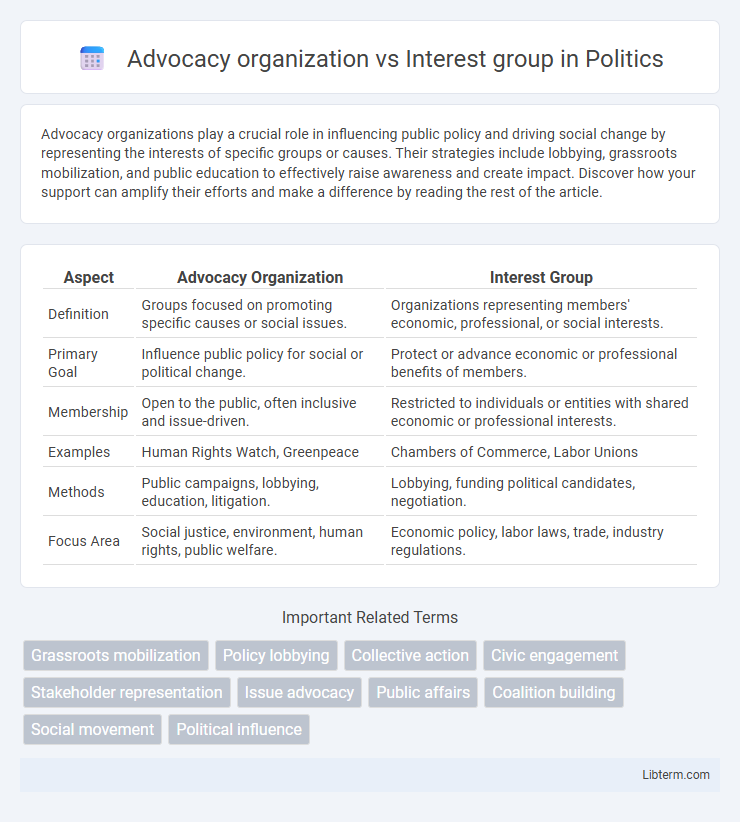Advocacy organizations play a crucial role in influencing public policy and driving social change by representing the interests of specific groups or causes. Their strategies include lobbying, grassroots mobilization, and public education to effectively raise awareness and create impact. Discover how your support can amplify their efforts and make a difference by reading the rest of the article.
Table of Comparison
| Aspect | Advocacy Organization | Interest Group |
|---|---|---|
| Definition | Groups focused on promoting specific causes or social issues. | Organizations representing members' economic, professional, or social interests. |
| Primary Goal | Influence public policy for social or political change. | Protect or advance economic or professional benefits of members. |
| Membership | Open to the public, often inclusive and issue-driven. | Restricted to individuals or entities with shared economic or professional interests. |
| Examples | Human Rights Watch, Greenpeace | Chambers of Commerce, Labor Unions |
| Methods | Public campaigns, lobbying, education, litigation. | Lobbying, funding political candidates, negotiation. |
| Focus Area | Social justice, environment, human rights, public welfare. | Economic policy, labor laws, trade, industry regulations. |
Defining Advocacy Organizations
Advocacy organizations are entities dedicated to promoting specific causes, policies, or social changes through education, lobbying, and public campaigns, often operating with a structured mission and professional staff. Unlike interest groups, which primarily seek to influence government policy to benefit their members' economic or social interests, advocacy organizations focus on broader societal issues and public welfare. Defining advocacy organizations involves recognizing their role in shaping public opinion, advancing human rights, and supporting policy reforms through strategic communication and grassroots mobilization.
Understanding Interest Groups
Interest groups are organizations that seek to influence public policy and decision-making to benefit their members or causes, often by lobbying, grassroots mobilization, or public campaigns. Unlike broad advocacy organizations that may address wide-ranging social issues, interest groups typically concentrate on specific economic, professional, or ideological concerns, such as environmental protection, business regulation, or labor rights. Understanding interest groups involves analyzing their strategies, membership structures, and roles within political systems to gauge their impact on legislation and public opinion.
Key Differences Between Advocacy Organizations and Interest Groups
Advocacy organizations primarily focus on promoting specific causes or policy changes through lobbying, public campaigns, and education, while interest groups represent the economic or occupational interests of their members, often aiming to influence legislation for direct benefits. Advocacy organizations tend to engage in broader societal issues and mobilize public opinion, whereas interest groups concentrate on advancing their members' particular interests through political contributions and lobbying efforts. The structural difference lies in advocacy groups being mission-driven with a focus on social impact, contrasting with interest groups that are membership-driven and focused on collective benefits.
Goals and Objectives: Advocacy vs Interest Representation
Advocacy organizations focus on promoting specific causes or social issues by influencing public policy and raising awareness, aiming for broad societal change. Interest groups primarily seek to represent the economic or professional interests of their members, working to influence legislation and regulations that directly benefit their stakeholders. While advocacy organizations emphasize value-driven goals, interest groups prioritize pragmatic outcomes tied to member benefits.
Organizational Structure and Membership
Advocacy organizations typically have a formalized organizational structure with defined leadership roles, staff, and clear governance policies to coordinate sustained campaigns and policy influence. Membership in advocacy organizations often consists of individuals directly involved in or supportive of the mission, sometimes requiring formal enrollment or dues. Interest groups tend to have looser structures, often formed around specific issues, with broad or informal membership comprising stakeholders, constituents, or affiliated entities united by common interests rather than formal commitments.
Strategies and Tactics Employed
Advocacy organizations employ strategic lobbying, public campaigns, and grassroots mobilization to influence policy and public opinion effectively. Interest groups primarily utilize targeted lobbying, political contributions, and coalition-building to advance specific economic or social interests. Both entities leverage research, media outreach, and direct engagement with policymakers to maximize their impact.
Influence on Public Policy and Legislation
Advocacy organizations specialize in shaping public policy by providing expert testimony, mobilizing grassroots campaigns, and engaging in direct lobbying to influence lawmakers and regulatory agencies. Interest groups focus on representing specific member interests through campaign contributions, political endorsements, and forming coalitions to sway legislation in favor of their agenda. Both play critical roles in the legislative process but differ in strategies and scope, with advocacy organizations emphasizing broader social causes and interest groups targeting narrow, sector-specific outcomes.
Funding Sources and Resource Allocation
Advocacy organizations primarily secure funding through grants, donations from charitable foundations, and individual contributions, emphasizing resource allocation toward public education and policy influence campaigns. Interest groups frequently rely on membership dues, corporate sponsorships, and political action committees (PACs), directing resources mainly to lobbying efforts and electoral support. The distinct funding sources drive divergent priorities in resource distribution, with advocacy organizations focusing on long-term societal change while interest groups target immediate policy outcomes.
Case Studies: Successful Advocacy Organizations and Interest Groups
Successful advocacy organizations like the American Civil Liberties Union (ACLU) leverage legal strategies and public campaigns to influence policy changes, exemplified by landmark cases on civil rights. Interest groups such as the National Rifle Association (NRA) focus on mobilizing member support and lobbying to protect gun rights, demonstrated by their impact on legislation and political candidates. Case studies reveal advocacy organizations often engage in broader social reforms, while interest groups concentrate on specific issues aligned with their members' interests.
Impact on Society and Democratic Processes
Advocacy organizations drive societal change by promoting specific causes, often engaging in public education and policy reform to influence democratic processes directly. Interest groups primarily represent member or sector interests, leveraging lobbying and political contributions to shape legislation and regulatory decisions. Both entities impact democracy by amplifying citizen voices, but advocacy organizations tend to emphasize broader social justice issues, while interest groups focus on protecting economic or professional benefits.
Advocacy organization Infographic

 libterm.com
libterm.com